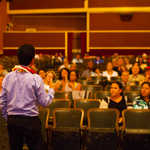

The Seven Teachings are part of the First Nations Peoples lives, living on the Prairies here in Canada
December 8th, 2013, 4am
It was -30°C. The breeze was light.
The Seven Teachings The traditional concepts of respect and sharing that form the base of the Aboriginal way of life are built around the seven natural laws, or sacred teachings. Each teaching honours one of the basic virtues essential to a full and healthy life. These 7 laws were symbolized and represented by animals, which reflected our connection to nature and our connection to the land. The spirituality of our people is deeply rooted and connected to the land. You cannot live on this land honoring all that there is on the land unless you understand these 7 laws. If we do not understand these 7 laws that we are inspired to live by, then there is a good chance that we will not respect the land and that we will disconnect ourselves from what comes from the land. But if we live by these 7 laws, that is when we will have a truly happy and peaceful life, in harmony with all of nature and each other as the human family. (Elder Dave Courchene) Love - Eagle The First Peoples of Turtle Island (North America) were to always carry out actions in LOVE. To feel true love is to know the Creator. One’s first love is to be the Great Spirit. You express love for the Great Spirit by loving yourself and how the Great Spirit made you. Only then can you truly love others. Children are to be loved, for children are gifts from the Great Spirit. To feel true love is to know the Creator. Therefore, it is expected that one’s first love is to be the Great Spirit. He is considered the father of all children, and the giver of human life. Love given to the Great Spirit is expressed through love of oneself, and it is understood that if one cannot love oneself, it is impossible to love anyone else. The Eagle was chosen by the Great Spirit to represent this law, as the Eagle can reach the highest out of all the creatures in bringing pure vision to the seeker. Though, the purveyor of the greatest and most powerful medicine, love can also be the most elusive of the teachings, as it depends upon a world that acknowledges the importance of spirituality. (MFNERC)
Courage - Bear To have COURAGE is to have the mental and moral strength to listen to the heart. It takes courage to do what is morally right. First Nations people were told to be proud of who they are and never to deny the way of life the Great Spirit gave to them. The Bear provides many lessons in the way it lives, but courage is the most important teaching it offers. Though gentle by nature, the ferociousness of a mother Bear when one of her cubs is approached is the true definition of courage. To have the mental and moral strength to overcome fears that prevent us from living our true spirit as human beings is a great challenge that must be met with the same vigor and intensity as a mother Bear protecting her cub. Living of the heart and living of the spirit is difficult, but the Bear’s example shows us how to face any danger to achieve these goals. (MFNERC)
Wisdom - Beaver To live in wisdom is to know that the Great Spirit gave everyone special gifts. Showing wisdom is using your gifts to build a peaceful and healthy family and community. When we know and use our gifts, we become an instrument of the Great Spirit, helping to bring peace to the world. The building of a community is entirely dependent on gifts given to each member by the creator and how these gifts are used. The Beaver’s example of using his sharp teeth for cutting trees and branches to build his dams and lodges expresses this teaching. If he did not use his teeth, the teeth would continue to grow until they became useless, ultimately making it impossible for him to sustain himself. The same can be said for human beings. One’s spirit will grow weak if it is not fulfilling its use. When used properly however, these gifts contribute to the development of a peaceful and healthy community. (MFNERC)
Truth - Turtle Always seek the TRUTH. The truth lies in spirit. Prayer was to be done every day at sunrise to give thanks to the Great Spirit for the gift of life. Each of the gifts and ceremonies were given by the Great Spirit to the Original human beings to help them find the truth and the true meaning of their life on Earth. Living the truth is living the Seven Sacred Teachings, living from the heart. To know truth is to know and understand all of the original laws as given by the Creator- and to remain faithful to them. It is said that in the beginning, when the Creator made man and gave him the seven sacred laws, the Grandmother Turtle was present to ensure that the laws would never be lost or forgotten. On the back of a Turtle are the 13 moon, each representing the truth of one cycle of the Earth’s rotations around the sun. The 28 markings on her back represent the cycle of the moon an of a woman’s body. The shell of the Turtle represents the body real events as created by the Higher Power, and serves as a reminder of the Creator’s will and teachings. (MFNERC)
Respect - Buffalo First Nations people were told to always RESPECT all life on Mother Earth. To show real respect is to share and give of yourself for the benefit of all life. Respect the Elders from all races of people who uphold the sacred teachings of the Great Spirit. The Buffalo, through giving its life and sharing every part of its being, showed the deep respect it had for the people. No animal was more important to the existence of Indigenous families than this animal, and it’s gift provided shelter, clothing and utensils for daily living. Native people believed themselves to be true caretakers of the great herds, and developed a sustainable relationship with the Buffalo resulting in a relationship that was a true expression of Respect. (MFNERC)
Honesty - Bigfoot To be HONEST with yourself is to live in the spirit of how you were created. Never lie or gossip about each other. The more honest you are the bigger you become as a person. Long ago, there was a giant called Bigfoot. Bigfoot walked among the people to remind them to be honest to the laws of the creator and honest to each other. The highest honour that could be bestowed upon an individual was the saying “There walks an honest man. He can be trusted.” To be truly honest was to keep the promises one made to the Creator, to others and to oneself. The Elders would say, “Never try to be someone else; live true to your spirit, be honest to yourself and accept who you are the way the Creator made you. (MFNERC)
Humility - Wolf Always carry out actions in HUMILITY. Think of your family, your fellow human beings and your community before you think of yourself. To know humility is to understand that you are not more or less important than anyone else. Being humble is surrendering to the Great Spirit, who has created and who directs all life. Recognizing and acknowledging that there is a higher power than man and it is known as the Creator is to be deemed truly humble. To express deference or submission to the Creator through the acceptance that all beings are equal is to capture the spirit of humility. The expression of this humility is manifested through the consideration of others before ourselves. In this way, the Wolf became the teacher of this lesson. He bows his head in the presence of others out of deference, and once hunted, will not take of the food until it can be shared with the pack. His lack of arrogance and respect for his community is a hard lesson, but essential in the Aboriginal way. (MFNERC)
I use these posters and teachings on the walls in my classroom, and we practice them so that we can practice to live a balanced life style. The students enjoy learning about each one and they also enjoy learning about the animals. We try to inter-grade as many Indigenous teachings as we can, even with the teepee teachings,language, making winter counts as journals and designing dream catchers and building the North American Indian Back Rest Chair. These are some of what I have learned and introduced to my students. The students enjoy learning of past history and try to picture it, so the more hands on you can create and tell the history in stories the more attentive they become and want to learn more.
The colors of Red, white, black and yellow, represent all colors of all nations.
Reference: Manitoba First Nations Resource Center – Manitoba Canada Elder Dave Courchene Elder Rosina McGillivary
Filed Under
Other moments in The Pas
-
prairie first nations, indigenous, Brandon Story Class
Suicide on reserves
in The Pas, Canada -
Brandon Story Class, indigenous, prairie first nations
Alcoholism on reserves
in The Pas, Canada -
prairie first nations, Brandon Story Class
Pike Lake Culture Daylocal artist: Solomon Colomb 2002
in The Pas, Canada -
prairie first nations, Brandon Story Class
A look back to The Oka Crisis, 13 years ago.Part of my Winter Count
in The Pas, Canada -
Brandon Story Class
Pearl exclaims;"Can I help you with your homework"
in The Pas, Canada -
prairie first nations, Brandon Story Class
The ulu knife, traditionally the handle is made from caribou antler or walrus ivory. The blade was made of slate, until metal was introduced during the Fur Trade.
in The Pas, Canada -
prairie first nations, Brandon Story Class
Art from Baffin Island.
in The Pas, Canada -
prairie first nations, indigenous, Brandon Story Class
White Feather
in The Pas, Canada -
Brandon Story Class, prairie first nations
Weaving Stories and TraditionsStorytelling and weaving are treasured aspects of indigenous peoples. Much time is put into both the weaving of the basket and the weaving of a story.
in The Pas, Canada




